|
"Ten
Narratives"
|
|||
|
Ten Artists
|
|||
|
|||
|
UMBRELLA
ARTS
317 East 9th Street (between 2nd & 1st Avenues in the East Village) New York, NY 10003 Free; Refreshments served. |
|||
|
Artist
Reception: Saturday, January 26th, 6 to 9 PM.
(click to view photos) Exhibition thru March 2, 2013. |
|||
|
133 Elm Street (Lower Level) New Haven, CT 06510 Artists' Reception: Saturday, March 23, 2 to 4 PM. Exhibition thru April 14, 2013. |
|||
|
Gallery
RIVAA
527 Main Street Roosevelt Island, NYC November 2 - December 12, 2013 Artists' Reception: Saturday, November 2, 2013 |
|||
|
CATALOG
|
|||
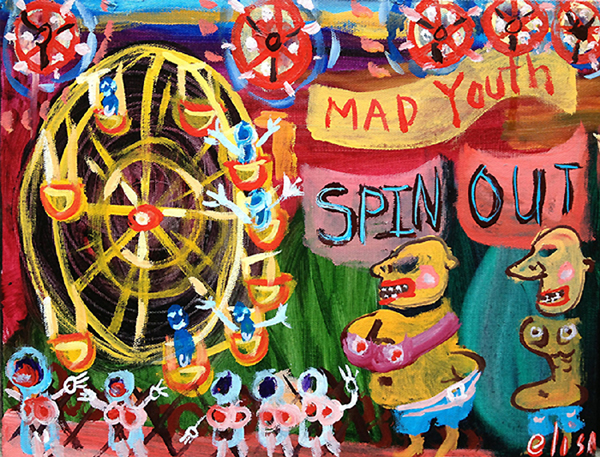 |
|||
|
Elisa
Vegliante -- "Mad Youth SPIN OUT"
oils on canvas, 17" x 14" |
|||
|
Curated
by Chris Butler - Butler Exhibition Design &
Johnes Ruta, AzothGallery.com, independent curator, writer & Art Director New Haven Free Public Library. A Catalog book with essay, written by Chris Butler & Johnes Ruta, will accompany this exhibition. |
|||
| Good
things come in small Spaces. "Ten Narratives" is
a substantial group show of Connecticut, New York, and California
artists to be housed in a small East Village Gallery, Umbrella Arts,
at 317 East 9th Street from January 24th to March 2nd. The exhibition
explores the art of the narrative through a broad scope of styles,
ranging from expressionist to surrealist to abstract to primitive,
with influences ranging from Eduard Munch to Joan Miro, Australian
Aboriginal art to Jean Dubuffet and Outsider Art. The ten artists
comprise an interesting cross section. Half are self-taught. Ages
stretch from mid-30s to mid-90s. Media include paintings, drawings,
etchings, collage, assemblage, mixed media and sculpture. Some of
their accomplishments include NEA fellowships, public sculpture and
mural installations, and publishing children's picture books. All
of these elements combine to make an exciting visual smorgasbord held
together by the narrative art form. Narrative is story-telling, mimesis, poetry, or the description of allegory. It is personal. Mimesis is mime or imitation, as in the imitation of character, or the imitation of tragedy. Aristotle says that tragedy is an imitation of action. Allegory is a style of fable in which the story is a means of teaching a principle of life, a principle of personal experience or external reality, principles of Forms, or a principle of science. Narrative is drama, adventure, romance, comedy, or satire. Drama reveals a conflict between two points of fact, two types of personality, two opinions, in which the outcome is unfortunate. Comedy works with the same factors, but where the outcome is happy. As Oscar Wilde says, "The good end happily, and the bad unhappily. --- That is what fiction means." But how do we create "narrative visual art"? This exhibition explores the art of the narrative through a broad scope of styles, ranging from representative, to expressionist to surrealist to abstract to primitive, with influences ranging from Eduard Munch to Joan Miro to Australian Aboriginal art to Jean Dubuffet and Outsider Art. The ten artists comprise an interesting cross section. Half are self-taught. Ages stretch from mid-thirties to mid-nineties. Media include paintings, drawings, etchings, collage, assemblage, mixed media and sculpture. Some of their accomplishments include NEA fellowships, public sculpture and mural installations, and publishing children's picture books. All of these elements combine to make an exciting visual smorgasbord held together by the narrative art form. In visual narrative, stories emerge from constellations of dots and strokes of paint, points of reference, shadows and overlays, forms and images, figures and objects. -- It often requires a new vocabulary to describe patterns, motifs, moods, and emotions. Carl Jung's so-called "archetypes" lay out patterns of personalities, symbols, and myths to explain recurring principles in living reality. In 1958, the anthropologist Claude Levi-Strauss wrote in Structural Analysis that the vast number of mythic stories in the world can be distilled into certain structures that are constant and universal. A.J. Greimas points out contrasting polarities in stories, such as subject/object, sender/ receiver, helper/opponent -- the individual terms of which are characteristic representations. As the word "arche" derives from ancient Middle Eastern language as "the eldest form," (such as the architectural arch, or the study of archaeology). Archetypes, the "eldest types," denote prototypes of personal characteristics and patterns of experience from which recognizable cultural stories and references emerge. Levi-Strauss also put forth the theory that myths have a sort of "collective existence" independent of individual thought (here reinforcing the theory advanced by Carl Jung of the "Collective Unconscious") -- that diverse stories can be distilled into allegorical explanations of physical and mechanical principles and translated into moral and ethical fables. In art, narrative representations can produce the immediate recognition of stories, dreams, motifs, or myths in figurative pictures. Narrative representations can also be perceived in ideas which gradually emerge from splotches of paint, points of reference, shadows and overlays of forms and other images, which merge into microcosms and macrocosms. Dynamic representations of narrative have developed through the centuries from friezes of ancient Assyrian lion chariots, to the "kouros" form of Greek figurative sculpture in forward motion, to Michelangelo's myriad paintings on the Sistine Chapel ceiling, the portrayal of heroic Chavaliers in Baroque Dynamism, and the paintings of Goya, Delacroix, and Edouard Manet. |
|||
| Elisa
Vegliante is a New Haven painter who also stars in husband
Ace Fronton’s backyard films as the eccentric actress Yahuba Daley.
Whenever she is not making art she is teaching art to elementary school
children. One of her many talents is extracting extraordinary pictures
from her students. Their art, in turn, informs hers.She ultimately
aligns herself with Outsider Art. In the 1990s Vegliante produced
a series of portraits and self-portraits during a period of obsession with the work of Eduard Munch, Vincent Van Gogh and Frida Kahlo. During this time she developed her own style of painting while simultaneously realizing that she was more interested in the psychological quirks that narrate the lives and souls of a culture than in painting portraits. In 1998 she abandoned portraiture to develop complex narratives in an over-amped expressionistic style she dubbed “Mondoexpressionism”. Vegliante’s painted narratives depict whimsical scenes in nearly indescribable detail of activity. “Mad Youth Spin Out” for instance, packs in an array of simultaneous actions occurring at the scene of an amusement park: two depraved adults and a line of young girls wait their turn to go on the Ferris-wheel, the buckets already spinning full of other kids whose arms are waving in excitement. The girls standing in line are crudely depicted with bare breasts suggesting the onset of puberty and, ultimately, the loss of innocence. Arty Fields of the Patterson Review sums up the artist’s exalted exposes perfectly: “Vegliante’s paintings … vividly illustrate the psychological and philosophical underpinnings of characters and events, the spiritual motivation behind things, rather than the things themselves… Her bold and shameless paintings provide an ongoing cultural diary of Western civilization’s mass hysteria at the breaking point.” www.mondoexpressionism.com |
|||
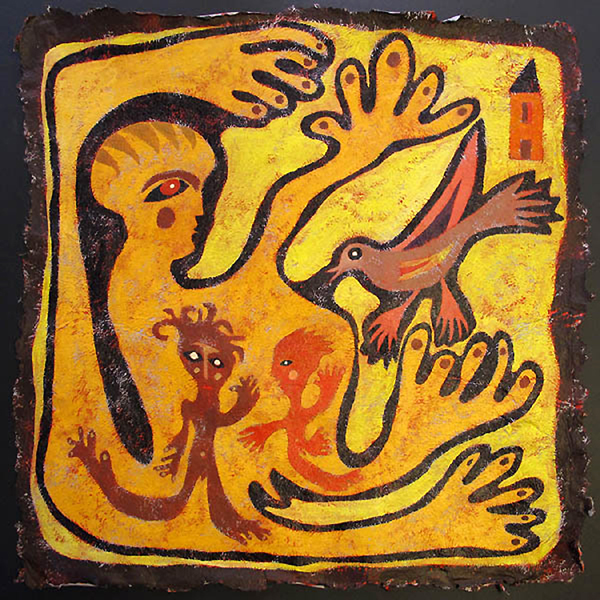 |
|||
|
Claudine
Burns-Smith
"Carlos Defending the Children from the Chickens" ceramic wall sculpture, 30" x 30" |
|||
| Claudine
Burns-Smith's
narratives relate to her love of family, mythology, and primitive
cultures. A painter, potter and sculptor, Burns-Smith is from Paris
and moved to the US in 1970. A self-taught artist, she lives and makes
art in Hamden, Connecticut using mediums that include handmade paper,
acrylics, paper pulp, clay and cement. As a child, she inherited from
her father an interest in ancient civilizations, mythology and primitive
cultures. In 1972 she moved to Colorado and studied the folklore of
the Southwestern tribes and the symbolism of their designs. During
a stay in Mexico, she wove textiles and made baskets in an attempt
to better understand the culture. She visited Olmec and Aztec ruins
and became very interested in their low-relief stone carvings. At
the same time she became interested in the theories of Carl Jung and
attended lectures on world mythology by Joseph Campbell. She also
spent time in the South of England, collecting old Celtic legends
about man-made hills, White Horses and ruins of the region. She visited
Stonehenge and the Standing Stones of Carnac in Brittany. Her interest in cultural, as well as personal, mythology is reflected throughout her work. Other primary influences include the art of Oceania and Dubuffet. The artist's approach is always intuitive. She does not plan artworks, but instead begins with a general idea, allowing only her imagination to dictate the imagery of a composition. She pays no attention to archetypes until after the art is completed. Only then does she sit back and take stock of what the piece is about. The narrative content of her artwork relates to her love of family, mythology, ancient civilizations and primitive cultures. She has exhibited in France, China, Russia and the US. www.burnssmithceramics.com |
|||
|
|
|||
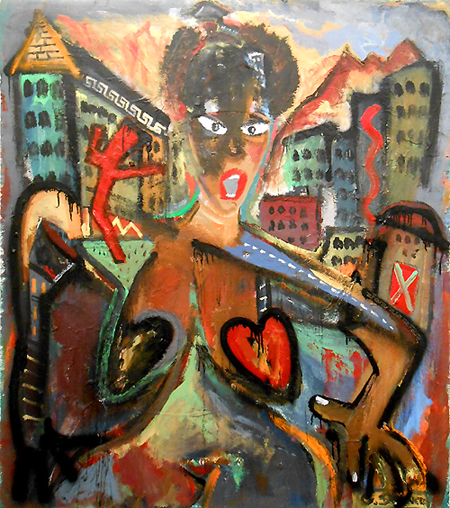 |
|||
|
Gordon
$kinner "Shante' "
acrylics, house paint, spray paint, on fibre mat board, 42" x 48" |
|||
| Gordon
Skinner
of Woodbridge, Connecticut, comes from a fashion design background.
His "masks" are wildly Dubuffet + Basquiat. Skinner's art
falls within the litmus of an identity in crisis. As a young African-American,
the frustration felt by the artist at his lack of ownership in our
society is something that is centuries old. He is part of a group
that feels fragmented, colonized and lost. As Skinner puts it "I
feel robbed of my heritage and culture". To vent that frustration
and sense of invisibility, he began painting figures in colorful masks
that represent both concealment and expression. Portraits of the members
of Skinner's fictitious "Gohar Tribe" are brought to life
through the artist's signature blend of bold color, spontaneous brushwork,
and a world of hard-edged life experiences. Personal and universal
revelations lie behind the visages. Full of vigor and animation, Skinner's work is raw, spontaneous and fragmented. It comes from a severely emotional place, creating an instant and intimate connection with the Viewer. Skinner's work is also reminiscent of a tradition and movement known as "Blues Impulse" comprised of artists who transform circumstance and hardship into extraordinary levels of visual content and artistic expression. Gordonskinner49@gmail.com balbert3@gmail.com |
|||
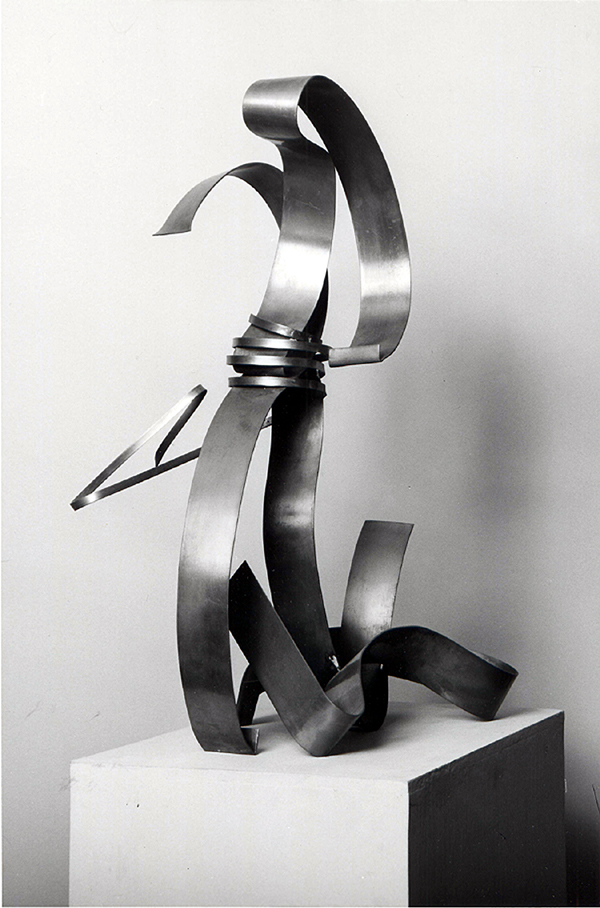 |
|||
|
Cherie
Tredanari "Vento d'Amore"
copper sculpture, 20" x 15" x 30" |
|||
| Cherie
Tredanari is
a 94 year old New York bohemian whose narratives tell the stories
of the Age of the Enlightenment: a series on scenes from Cervantes'
Don Quixote de La Mancha, Shakespeare's s Romeo and Juliet, and the
winds of love. "Vento d'Amore" expresses how important
"movement" is to her: movement through time as well as through
space. Her rounded steel sculptures attract attention with curvature,
light and fluidity, such as the two intertwined figures in love. Her
sculptures are abstract narratives that are sometimes whimsical, sometimes
stately, sometimes delicate, always vital. Tredanari lives on Manhattan's Upper West Side and still creates metal sculptures and then builds pedestals for them. She studied with such figures as Arthur Melzer, Paul Gill, and Henry Snell, and has designed many large sculptures, including one installed at Broadway Malls in 1983 titled "Number 11 Perspectives," dedicated to Duke Ellington. In 1981, at the request of Saks Fifth Avenue, Tredanari installed 13 of her sculptures in their Fifth Avenue display windows. Her home was a salon where artist friends came to visit and talk art , drinking wine from bottles bearing the Tredanari label, produced by family vineyards. |
|||
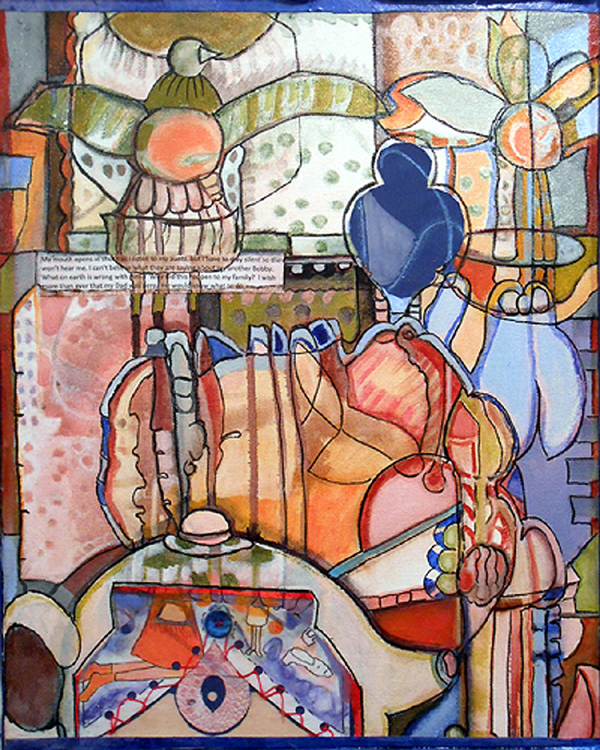 |
|||
|
Helene
Burke "Teapot #3"
mixed media on canvas, 16" x 20" |
|||
| Helene
Burke of NYC has a more architectural view of narrative, with
a visual vocabulary of biomorphic surrealism, descended from such
painters as Miro and Kandinsky. She is an NEA fellowship recipient
(1992-93) with a background in painting and found object sculpture,
currently working in mixed media collage. Burke has published two
children's picture books, pieces of which appear in her collages.
Abstract figurative objects appear as if sleep-walking. Beginning
her collages by doodling just as Miro used automatic-drawing to begin
his biomorphic works, she then combines her own drawings, cut up paintings,
exotic papers, pages from her books, thin layers of acrylic paint
and splotches of walnut ink to create dreamy landscapes of furniture,
plant forms and domestic interiors. The Teapot has become Burke's metaphor for "domestic chaos". Tea (or dinnertime) is presented as a setting where problems in the home are suppressed in favor of a trained pleasantness. Burke introduces the voice of a nine year old child by cutting out sentences from the pages of one of her children's books. The Viewer initially experiences the child's confusion and discomfort from all the subtexts that are going on in the piece. But familiar organic and domestic forms create a feeling, first of "deja-vu", then of compassion, and finally, of resolution. The alternating layers of cool and warm acrylic bathe the images in light. Her narratives explore childhood innocence and healing of the inner child, and personal transformation that creates Hope. Iamburke@aol.com http://azothgallery.com/azothgallery/Helene-Burke.html |
|||
 |
|||
|
Nick
Grossmann
"Nephilem Invade the Little People Village" oils on canvas, 24" x 30" |
|||
| Formerly
living the life of an Outlaw, Nick Grossmann went on
a self-imposed exile in his mid-twenties, spending a lot of time alone,
practicing meditation, learning voodoo, meeting with a Shaman, finding
his truths and coming to terms with his identity. His personal experiences
are the episodes that he transcribes to his painting media - his neighborhood
locales, the characters of his childhood, and scenes of his travels.
Growing up in Norwalk, Connecticut, he knew he was a rebel by the
age of fourteen and expressed his inability to "fit in"
by identifying himself as an "Outlaw". This dynamic continued into adulthood. His creative outlet during that time was composing and playing music. He liked to call himself a "Troubadour". His young son, Dylan, and a few important friends also helped change the course of his life. These personal gains finally led Grossmann to an art store where he purchased paints, brushes and canvases; he has been painting ever since. Now "the Artist", his self-concept has evolved from Outlaw and Troubadour, to "Vagabond" and "Street Mystic". These identities, powered by a new found inner freedom, have fueled the style of his art. His most recent series "The Urban and Aquatic Adventures of Mickey Wolve" features a character of superhero stature, a "Sea Gypsy" by the name of Mickey Wolve. This persona derives from Grossmann's childhood obsession with superheroes. The superhero metaphor became essential to the artist's tolerance of society and eventually metamorphosed into his present spiritual devotion to help those who are less able to fend for themselves. His art traces his inner path; each painting is a piece of narrative, the story drawn from Grossmann's many adventures. Working with vivid oil colors, the array of Nick Grossmann's paintings become bold visions of alternate adventures and dream realities. Images are forged in heavily textured layers of bold, bright color. Closer inspection reveals hundreds of etchings as the artist scratches shadows, submerged and emerging forms, and details into freshly painted canvas. His painting titled "The End of You" was included in the 2011 annual Nurture Art Benefit held at the Chelsea Art Museum. www.mickeywolve.com |
|||
|
|
|||
 |
|||
|
Moira
Fain "The Hallow"
mixed media , 24" x 40" |
|||
| Moira
Fain tells her stories through symbolism and the boxed-in
world of the diorama, which she refers to as her "collage boxes,"
a format she began constructing during the 1990s. They descend from
the earliest art she was exposed to as a child: the Catholic Church's
Stations of the Cross, which consisted of three-dimensional sceneries
that had plaster frames and projected out from the wall. Fain describes
a "push" inside her to produce metaphors as a means of making
sense of life. The primary themes in her collage boxes are mother,
father and the triangle of mother-father-child. The rabbit appears
frequently as a metaphor for the wild and unpredictable father. Children
represent erotic love. The mother symbolizes power. Steeped in childhood
imagery and ominous overtones, the collage boxes recall childhood
confusion and conflicted relationships with parents, overshadowed
by the impending loss of innocence. As adult understanding emerges,
personal experiences are understood; the collage boxes become less
detailed and more focused. Finally, in later works, the art starts
to take over the narrative. From Connecticut, Moira now lives in Landers,
California, in the Mojave Desert. She has also published a children's
book with beautiful illustrations rendered in oils. www.moirafain.com
|
|||
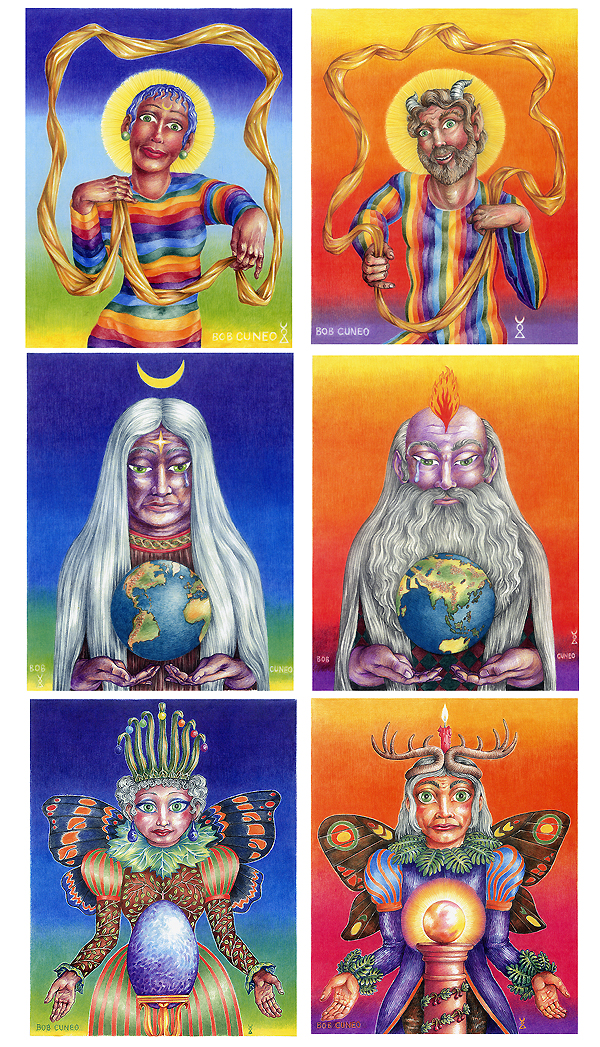 |
|||
|
Bob
Cuneo "6 Deities" (6 of 12)
Dancing Goddess & God Elder Goddess & God Enchanted Goddess & God derwent pigmented leads, each 8" x 10" |
|||
| The
history of the narrative art form evolves in artworks such as Bob
Cuneo's visionary portrayals of six pairs of Primal Gods and Goddesses,
which convey the sensation of cosmic consciousness and Illumination.
In his twelve small paintings from his series "Thought-Form Divinities
: Astral Images of the Great Goddess and the Primal God by a Wiccan
Iconographer" Cuneo relates his symbolism and mythic pictorial
imagery to the Hermetic Traditions of alchemy, pagan magic, ancient
wisdom, and Renaissance story-telling. Painted in the Magic Realist
style, these pairs of six divine archetypes (Dancing Goddess &
God; Enchanted… ; Elder… ; Lithic…; Radiant… ; Organic…) are manifested
in radiant pigment colors. Their faces gaze out to the viewer with
the clear eyes of frankness, kindness, and mystery, their costume
garb telling the symbolism of their place and purpose in the universe,
and their roles among the other gods and in the lives of earthly men
and women. Cuneo is a retired Professor of Fine Arts from the University of Bridgeport where he taught from 1969 to 1989. After leaving his tenured post at U.B., Cuneo also moved away from the ideas of contemporary art and devoted the essence of his work to the rituals and symbolism of neo-pagan Wicca, and the landscapes of Classical harbor cities. He became a staff artist for the nature/spirituality quarterly CIRCLE MAGAZINE, which has featured his ink drawings and color covers since 1985. http://www.seezoo.com/cuneo.htm |
|||
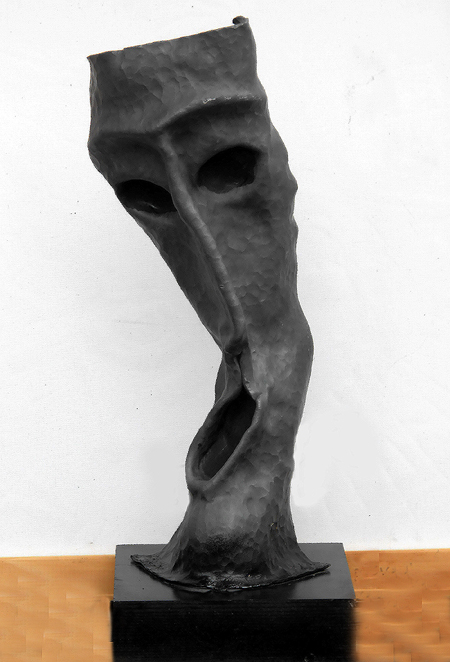 |
|||
|
Dana
Naumann "The Narrator"
lead pedestal sculpture , 8" x 20" x 6" |
|||
| Dana
Baldwin Naumann's narratives are hammered out of sheets of
lead into the forms of religious, mythic and archetypal figures, reminiscent
of the art and artifacts found amongst ruins of an ancient civilization.
His themes express compassion, humanity, whimsy, mystical and exotic
sensations, such as "The Thought Just Came to Me," "The
Artist as a Young Man," and "There is a Smile If You Look."
Naumann is a former corporate executive reincarnated as a self-taught artist, a metal sculptor and painter residing in Branford, Connecticut. His style stretches from primitive to expressionistic, painting faces juxtaposed with landscapes, and sculpture heads or bodies which tell their own stories. He finishes the metal in zinc or copper patinas which impart a warm glow and add a feeling of softness to the hard surfaces. The idealized woman and romantic love are also themes that he frequently revisits. www.naumanngallery.com/ |
|||
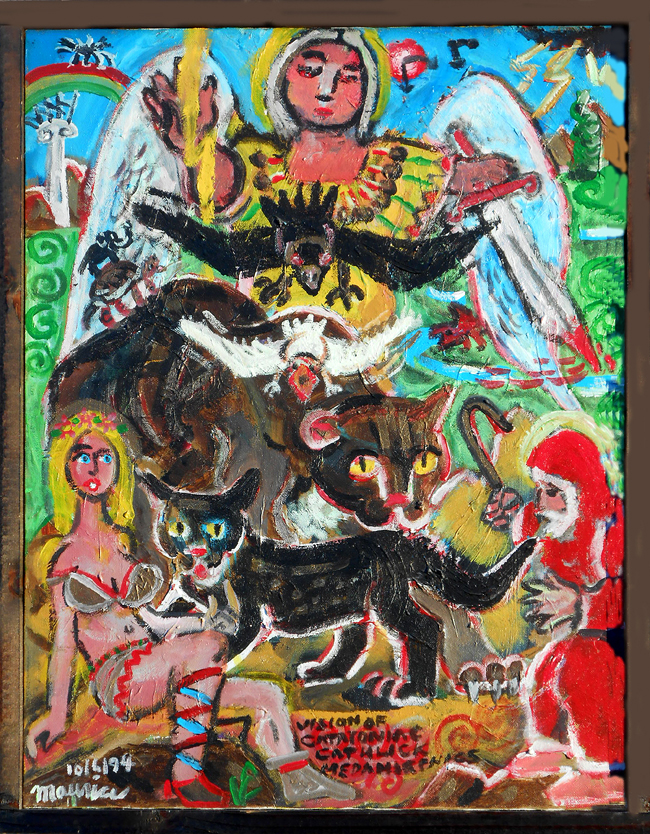 |
|||
|
Maurice
Hansen "Vision of Catatonic Cathlick Medamorphics"
acrylics on canvas, 19 1/2" x 20 1/2" |
|||
| In
Memoriam . . . Maurice Hansen (1941 - 2000) The late New Haven Outsider Artist, Maurice Hansen, created an endless stream of paintings, poems, plays and videos in an elaborately quirky environment of his own making from 1960 until his untimely death in 2000 from Lymphoma at age 59. In 1993 his retrospective "Inner Visions", which included 63 paintings spanning four decades, was curated by Whitey Jenkins and held at the Aetna Center Gallery in Hartford. Outsider art critic and Director of the Benton Museum in Storrs, Sal Scalora, called it a "tour de force". This exhibition sparked the subsequent steady flow of solo and group shows which had been long overdue. His exposure over the next seven years included such venues as the Cork Gallery at Avery Fisher Hall in Lincoln Center where he exhibited his 30 foot mural of Coney Island; the Bridges + Bodell Gallery on East 7th Street where he exhibited his 25 foot mural of the 3rd International Outsider Art Fair. Hansen's art was also exhibited during the early years of the Outsider Art Fair at the Puck building in Soho. Reviews of his shows were featured in the New York Times, The New Haven Register, The Advocate, Art New England, Provincetown Art, Folk Art Finder and the Hartford Courant. Hansen was also included in Betty-Carol Sellen's and Cynthia J. Johansen's resource book "Self-Taught, Outsider and Folk Art: A Guide to American Artists, Locations and Resources", 1999. Hansen and Maximalism Maximalism began to appear as a movement in painting during the 90s in both Europe and the US, having been initiated in a catalog by filmmaker and painter Daryush Shokof of Cologne, Germany for his 1990 solo exhibition at Galleria Verlato in Milano, Italy. As a visual art form it is elaborate in design, ornate in detail and bright in color. In the catalog for that show Shokof wrote some of his thoughts on Maximalism: "Unbalancing the Chaos = Balance = Life = Maximalism" and "Life for a Maximalist means actions committed by every moving creature." A year later Shokof's "Maximalist Manifesto" began appearing in his exhibition catalogs asserting that, as an aesthetic, Maximalism "is open to wide views and visionary dimensions that can be fantastic, but not deformed". Back in New Haven, at roughly the same time, Maurice Hansen found that, to catch attention in our frenzied environment, the artist can reinforce his concepts with multiple subtexts and elaborate detail. In a captivating, wildly expressionistic style, Hansen flaunted these visual excesses as a self-proclaimed Maximalist. In a 1994 exhibition at the York Square Cinema Gallery in New Haven, "Castles, Kings and Carnivals; The Maximalist style of Maurice Hansen", the artist displayed his fully developed philosophy, vision and style. Hansen's Narratives Maurice Hansen's starring role was as a painter of narrative. Through decades of painting Biblical subjects as well as contemporary cultural and political events, Hansen took the art of visual narrative to a whole new level. One of his better known paintings "Starry Night of the Kingdom Come" (property of Beverly Kaye Gallery) is an apocalyptic vision which depicts an extravaganza of cultural icons and religious references interwoven with subplots and miscellaneous annotation, and which ironically result in a painting that celebrates life. |
|||
| Contacts:
Chris Butler (203) 988-2412 christinebutler_ccs@hotmail.com Johnes Ruta (203) 387-4933 azothgallery@comcast.net UMBRELLA ARTS 317 East 9th Street, New York, NY 10003 (212) 505-7196 Gallery Hours: Thursday thru Saturday, 1 to 6 PM. |
|||
|
|
|||
|
Artist
Reception: Saturday, January 26th,
6 to 9 PM. Exhibition thru March 3, 2013. |
|||
|
|